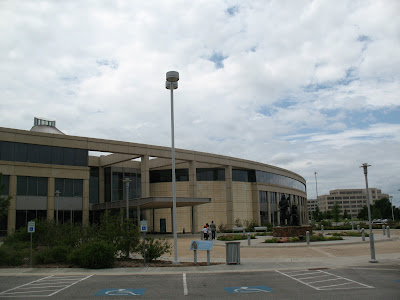The
Museum at the Indian Pueblo Cultural Center in Albuquerque, New Mexico is part of a large complex of educational and meeting facilities. We arrived, unfortunately, about an hour before closing time, so our visit was a little rushed--it's another museum that I would love to re-visit before long to spend more time.
 |
| At entrance to the Center |
Visitors are greeted at the entrance from the parking lot to the museum by a larger-than life statue of a figure carrying a tablet and draped with a blanket bearing crosses.
Inside, the museum has an informal atmosphere. One room near the entrance displayed dozens of dolls representing different groups of Pueblo Indians. The figures were beautiful and detailed, set off in groups against a very blue background. One emphasis of the museum seemed to be an appreciation of the unique character and culture of each different group, so this exhibit and the rest of the museum provide an interesting lesson in the diversity of Pueblo cultures.

The rest of the museum is a little complicated to follow, at least if you're on a time constraint, as we were. I would definitely recommend reviewing the map/layout material and some of the background information before navigating the museum. The artifacts and information are displayed in a series of hallways doubling back and forth, and I wasn't always sure what the connection between exhibits was. Later in the hotel room, I found the
map, and was able to piece together what I'd seen earlier. If possible, plan ahead, visit the website, and find out what other events and tours are available. We could see that the museum had several interactive and dramatic displays, but these were shut down by the late afternoon.
A large part of the material we saw focused on the work of contemporary artists, with some rather stunning murals, painting, and sculpture. This seemed to be a departure from many other institutions dedicated to Native American culture that focus almost exclusively on historical artifacts. We also saw a contemporary exhibit called "
Saints of the Pueblos," depicting the patron saints of all the different Pueblos. I found this interesting again, because it was contemporary, and because, as a native of California, I had always associated the Catholic Church with Mission Indians. I hadn't realized their role in the culture of the Pueblos. This exhibit will be running through 2011, according to the website.
Some of the area seemed to be under construction (in July 2010), so we had a little trouble figuring out where to go once we exited the main exhibit area and found ourselves in a courtyard. Perhaps the late time was also a factor, as guides or docents may have left for the day by the time we made our visit.
The gift shop was extensive, and rather upscale. A large collection of beautiful shirts and other standard souvenir collections was available, but the shop also had a fine jewelry counter. The shop also featured an extensive display of books for all levels and educational materials, along with crafts and fine art.
So, if you are going to be in the area, plan ahead and spend some time here, probably about 2 hours for a family with school-aged children.
The Harvest Cafe and Bakery was closed when we visited, but it looks like a great way to finish out a visit to the center. Hope we can try it out next time we're in the area.
 |
| Mural on display at museum |
From the Museum Website:
Hours:
Cultural Center & Museum: M-Sun 9:00 a.m. - 5:00 p.m.
Closed major holidays
Gifts: M-Sun 9:00 a.m. - 5:30 p.m.
Closed major holidays
Pueblo Harvest Cafe: M-Th 8:00 a.m. - 8:30 p.m.
Fri, Sat 8:00 a.m. 9:00 p.m.
Admission Prices:
Adult (18 and over): $6.00
Senior (62 and over w/ID): $5.50
New Mexico residents (w/ID): $4.00
Students (w/ID): $3.00
Children 5-17: $3.00



























